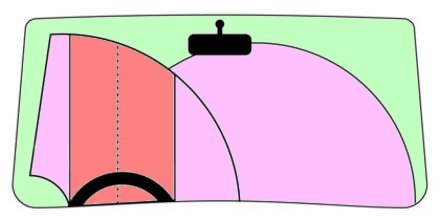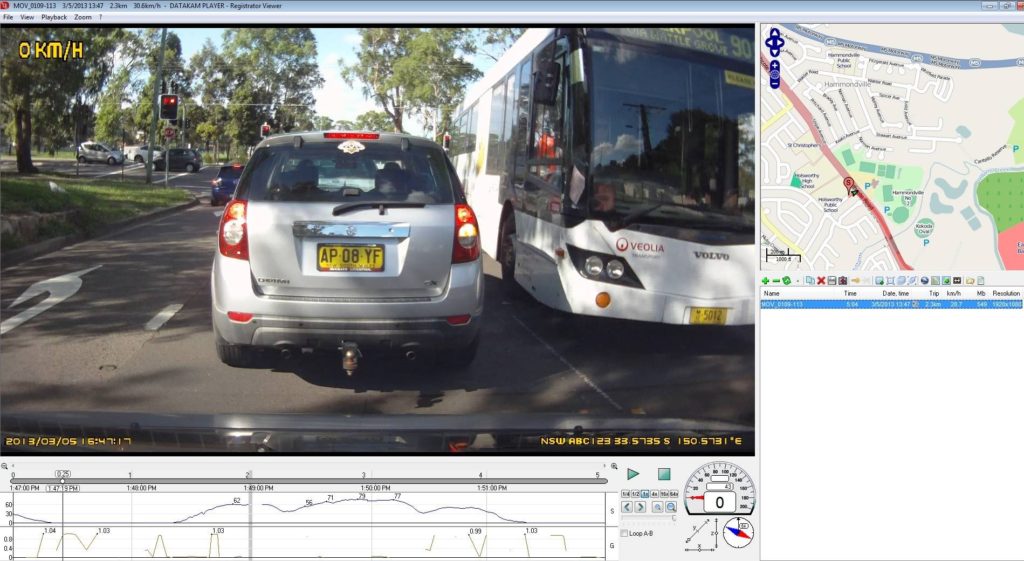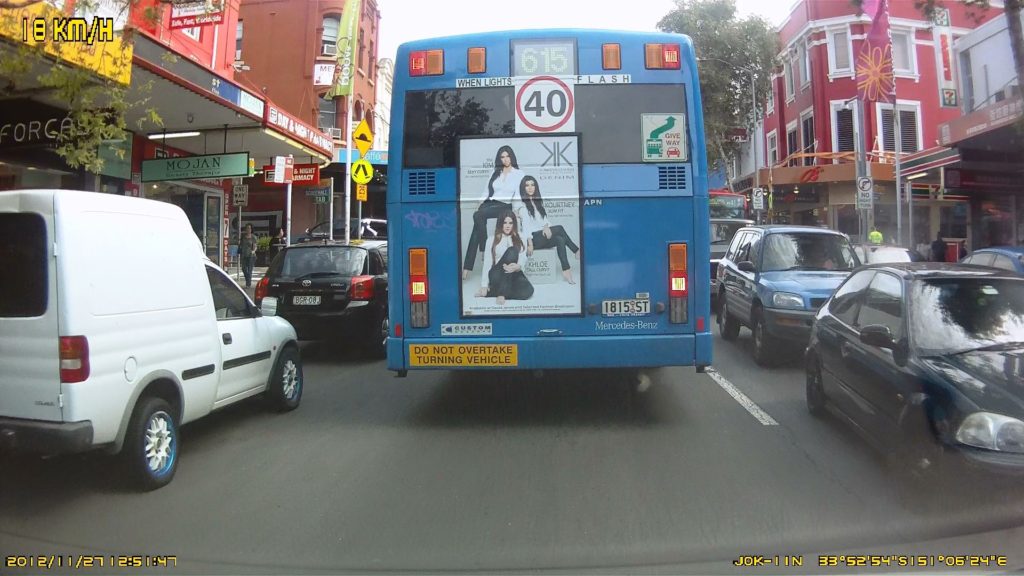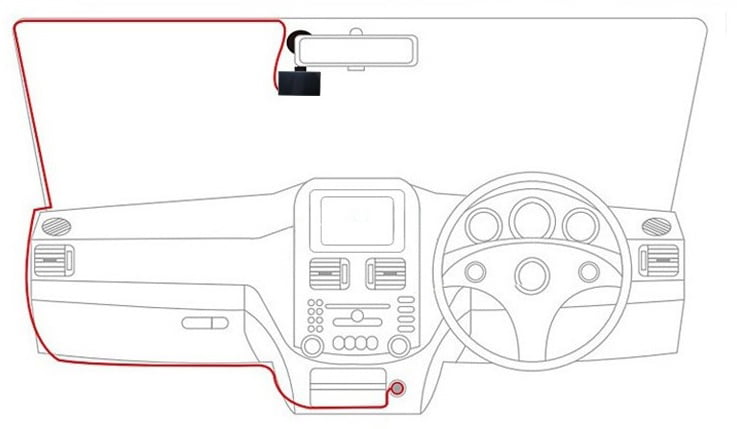Frequently Asked Questions
GPS – whats it all about?
The primary function of the in car camera is to capture video, goes without saying, having GPS logging though makes the evidence collected all the more worthwhile.
Knowing you have video of an event is great but having the exact time and location recorded takes the worry out of having to remember to collect these details yourself, you can also embed your own information if you choose such as your name or vehicle details. It is also possible to have these details logged but not embedded into the video.
The included Windows playback software gives a comprehensive overview of the circumstances that correspond to your videos, time and date, location and detailed map information relating to the journey, direction of travel, speed and 3 axis G-Sensor information are all logged.
(Click image for expanded view)
How does a car camera focus?
Unlike regular handheld cameras or mobile phone cameras that use auto focus to constantly adjust to changing subject matter, in car cameras are by design always meant to be solidly mounted and in a fixed position, additionally the area we’re most interested in capturing is that immediately in front of the camera and within a predefined range, due to the consistency of the location we are most interested in recording in car cameras use a fixed focus lens system, this provides a sweet spot where within that defined area we’ll have a nice clean picture and beyond that area the focus will gradually soften off.
The picture attached shows the areas closest to the vehicle have plenty of detail and as you look further afield the picture softens off and is less sharp.
Providing the camera is solidly mounted, has good hardware specification and sufficient recording bitrate then this area within the sweet spot of the lens will capture detail well enough to be able to clearly identify objects, even when traveling at speed.
(Click image for expanded view)
Car Cameras and image sensors
Car cameras present a difficult environment at the best of times, using a purpose designed CMOS image sensor improves the results dramatically, a good quality sensor can offer results that equal or sometimes even better those of much more expensive sensors found in high end video cameras and yet be able to support a wider range of operating temperatures
The AR0330 sensor by Aptina USA is a proven performer with excellent all round results and offers operating temperatures of -30°c right through to +70°c
This demonstration of the Aptina AR0330 CMOS Sensor shows a comparison to a higher specification camcorder over a wide range of lighting extremes
Memory Card usage
Car cameras use a ‘first in, first out’ recycle strategy, the setup menu will offer some options to set the desired recycle length listed in minutes, the recording is seamless but will be broken into more manageable sizes, think of it as being a bit like a DVD movie, the movie is continuous but for the sake of easier navigation is broken into chapters which allow you to easily navigate, skip forward, or back to a desired point when reviewing the recordings.
Being able to quickly navigate to a desired section is obviously a benefit but there are other reasons for doing this, as mentioned the cameras use a ‘first in, first out’ strategy for file handling, what this means is that the camera may for example be set for 5 minute recycle size, it will create a new file (or chapter) each five minutes, once the memory card reaches near capacity it will delete the oldest file to make room for the next recording, doing this ensures the most recent hours of driving are always available.
Cameras that have G-Sensors also have the ability to lock a file based on an event so in the case of an accident it can lock the currently recording file to prevent it being overwritten once the card reaches capacity, there is also an option on the cameras to manually lock files to protect them from being overwritten.
Writing the files in smaller sections or chapters also makes file handling much easier if you only need to keep a small section of a recording or an event, the recordings can be quite large if longer recycle times and higher bitrate (quality) settings are used.
A recording calculator, where different size memory and bitrate settings can be entered to work out how many hours of footage can be stored, can be found here: http://dashcamtalk.com/recording-time-calculator/
Where to mount your camera
Once you get an in car camera you need think about the ideal mounting location, before you get to deciding where you’d like to install it, you should check on the legalities of using it, in some countries in car cameras are not legal, in others you may need to make sure there is a warning sticker visible to notify your passengers that their conversations may be recorded, in some the use of suction mounted cameras is a problem and there may be rules associated with the LCD screen and when it is permissible for the display to be on.
Legalities aside there are common sense rules that will always apply regardless of where you want to use the camera.
The camera should never block your field of view and should not be in a position to distract you, LCD screens and LED lights in your direct line of sight are easily distracting, particularly at night, for most vehicles the ideal location is behind the rear view mirror to keep it out of sight, what you do want though is to make sure that the camera lens is within the sweep area of the windscreen wipers so that you can keep the window clean in front of the camera.

Pic 1. The area pictured in red should always be unobstructed; the area behind the mirror covered by the sweep of the wipers shown in pink is the preferred mounting location.
Mounting up high on the window like this also gives the best field of view for the camera, you will most likely find that if you adjust the aim of the camera for more road and less sky you’ll obtain the best results from the auto white balance of the camera, there’s no perfect setting that is correct for all vehicles so a little trial and error is required to find the optimum results.
Running cables
Once a mounting location is decided for your in car camera it’s important to consider the cabling, car cameras are typically supplied with power cables around 4 meters in length, this is to allow enough cable to be able to get from the top of the windscreen to a power outlet while being able to hide the cables for a more discreet installation.
For cameras that have direct 12v/24v input it may be possible to obtain power within the roof space, from an interior light or powered mirror circuit, some vehicles have auxiliary circuits in this ceiling space already but regardless they should always be checked to ensure they are appropriately fused and whether they offer switched or accessory power depending on your installation needs.
Under no circumstances should power ever be taken from any circuit related to SRS airbag systems.
When running the cables it is important to always run the wires on the passenger side, in the event of a cable not being secured correctly or coming loose while driving, if on the passenger side there is less chance of distraction and no chance of your vision being obscured or cables interfering with the controls as could happen if the cabling was run on the driver’s side.
Memory Cards – Whats best? Whats even suitable?
Card types
There are three different types of card: SD, SDHC (High Capacity) and SDXC (eXtended Capacity). The original format introduced in 1999, the SD card, could hold up to 2GB of data using Microsoft’s FAT-12 or FAT-16 file format. In 2006, when the 2GB limit was becoming too small for many devices the industry introduced the high capacity SDHC cards that could store up to 32GB using FAT-32. (SDHC are the card type most commonly used in car cameras today)
In 2009 an updated format was introduced, the SDXC card, able to store up to 2TB using Microsoft’s proprietary exFAT (Extended File Allocation Table) format. Apple added support for the exFAT file system starting with Mac OS X 10.6.5 (Snow Leopard), Being a proprietary file system though means that many cameras are not yet able to fully support the SDXC format.
File format
Although it is possible to format memory cards via computer the computer operating systems don’t fully comply with the SD file system protocols, however the SD Card Association provides a free SD Formatter 4.0 for SD/SDHC/SDXC program for Windows and Mac OS X for people who want to check or reformat cards. This optimises performance and protects the Secure Digital card’s secure “Protected Area”.
Card speed
The SD Card Association has different classes of cards, and produced mandatory logos with the class number inside a big C. the designation is as follows, Class 2 is 2MBps, Class 4 is 4MBps, Class 6 is 6MBps, and Class 10 is 10MBps or faster, faster cards are often marked with the speed in large type, such as 45MB/s or 90MB/s.
It should be noted that the class rating designates a minimum speed, not the actual speed. A good quality Class 2 card may outperform a Class 6 or even a Class 10 card. The only way to find the real performance of a card is to test the card using benchmark software
These minimum speed ratings are calculated in megabytes per second (MBps), usually written as MB/s on cards is actually eight times faster than megabits per second (Mbps), there are 8 bits in a byte. For example a 2MBps card is a 16Mbps card.
Read more about card speed here
System Bus Speed
The speed rating of the card is an important consideration for recording full high definition video, however the system bus may also influence the speed at which a particular device can send data to the card. The initial SD format used what is now referred to as the standard bus, once speeds reached 10MBps and above (Class 10) however a faster bus was needed, the High Speed Bus was introduced to handle the faster data write speeds. Beyond that there is the Ultra High Speed Bus (UHS-I), and the even faster (UHS-II), more information on the performance and markings for these can be found here
So what to use?
A good quality Class 6 (6MBps) card or above should handle Full HD (1080p30fps) video at up to 15Mbps data rate. UHS-1 cards may not be compatible because the new bus has new pins and reassigns some old pins. Cards with both logos – ie C10 and U1 – may work, but will often cost more. They still won’t write data faster than your camera can send it so a good quality Class 6 or Class 10 card is often a better choice.
Not all memory is created equally. Personally we use and recommend Samsung memory cards but have also achieved good results from Toshiba, Panasonic, SanDisk, Transcend and PNY.
Panasonic invented the SD format, and developed it with SanDisk and Toshiba.
What not to use?
Non branded memory carries the greatest risk of the unknown, online sellers are renowned for supplying memory that is fake or low grade and it is best to buy with caution. The primary reason to have a car camera is to record video evidence, given the importance it’s always best to use quality memory, if you are experiencing unexpected results with the recordings it’s wise to test the memory to make sure it is performing up to spec, the H2testw memory card analysis software can be downloaded from here this can help you to test the card for errors and identify if the card is possibly fake or has been relabelled to a higher speed than actual.
Understanding GPS performance for data logging in car cameras
It’s important to understand how the GPS functions as to why it behaves the way it does, with car cameras the priority is always video and processing power is allocated more for video than anything else, you’ll notice car cameras typically boot and start recording very quickly, GPS is a lower priority process and it will hunt for a signal after a recording has commenced.
There are three distinct modes for the GPS, cold start, warm start and hot start, most people would be aware that it takes three satellites to get a lock, the GPS will increase accuracy as more satellites are locked and will sometimes lock 7 or 8 satellites at once, each satellite provides its own position information and instructions to the receiver known as Ephemeris data, the download of this information takes 12.5 minutes (if it all comes down error free, otherwise it starts again), this data provides accurate forecast position information valid for the following few hours but only for that particular satellite, there is also Almanac data which is much less accurate but valid for much longer periods and for all satellites, obviously you typically get a signal much faster than 12.5 minutes and some basic triangulation and positioning info can be provided relatively quickly in some circumstances depending in the state of the GPS, cold, warm or hot.
A cold start is when the GPS has been off for more than 4 hours and this process must begin from scratch each time based on Almanac data of roughly where the Satellites might be.
A warm start (for most solutions) is around 30 minutes, if the GPS had signal within 30 minutes prior to a restart then the Ephemeris data collected is still valid and the GPS has an idea which Satellites to look for and reasonably close to where they should be at the time, the warm start is generally quite quick in comparison to a cold start, GPS solutions that have an internal RTC battery can often offer warm start times that are longer than 30 minutes.
A hot start is when you have a signal already and you drive out of coverage, through a tunnel, under a bridge or similar, when you come back into a coverage area the GPS knows what Satellites you were connected to and will look straight back to those same ones and will pick the signal back up very quickly.
It’s typical behaviour for the GPS to be slower to catch the signal initially when starting up undercover and with no signal, when there is no signal and a cold start or warm start happens if you don’t get access to open sky within a relatively short time the GPS effectively gives up looking where it thinks it should be looking and starts looking elsewhere for signal which might not always be the appropriate location so it will take a bit to get back to where it needs to look.
GPS has got smarter over the last few years and there’s things like forward error correction to improve cold start performance and there’s options like dropping invalid data for situations like the GPS starting up when there’s no signal to be had to try and improve the cold start hunt time, it’s quite an involved process though and something that is still being improved.



